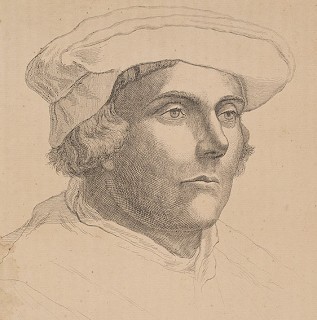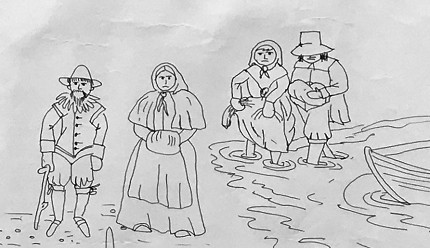This panel looks at some historical happenings in the stormy period of 1500 to 1700, collected under the title ‘Turbulent Times’. The huge national changes in both religion and politics made themselves felt locally and some significant local people came to the fore.
Henry VIII established the Church of England in 1534 after being excommunicated from the Catholic Church. His daughter Mary re-established Catholicism in her reign, only for it to be reversed under her younger sister Elizabeth I. Persecutions and martyrdom of people of the “wrong faith” were common throughout the land.
The Civil War brought more turmoil, with Charles I executed in 1649 and Britain then a republic until 1660, with the Puritan Oliver Cromwell as Lord Protector. These deep religious divisions sadly overshadowed the key quality of love that is central to God’s character.

James Boteler (or Butler, which is probably derived from the Boteler’s hereditary title of ‘Butler of Ireland’ given by Henry II in around 1170) was the 5th Earl of Ormond. He inherited Rochford Hall from his ‘de Bohun’ grandmother around 1450 and later added Viceroy of Ireland and Earl of Wiltshire to his titles. He supported Henry VI and the Lancastrian faction during the ‘Wars of the Roses’ and became Earl of Wiltshire. He fought in a number of battles but was executed following the Yorkist victory at Towton in 1461. As a result, his family lost possession of Rochford Hall when the Manor was given to the Duchess of Exeter, the Woodvilles, and then to the Greys.
In 1485, Henry VII became the first Tudor king and Rochford Hall was returned to James Boteler’s brother, Thomas, 7th Earl of Ormond. The Ormond coat of arms appears on the fine brick tower of St Andrews church, which presumably they paid for and built, as well as adding to the Hall.

When Thomas Boteler died in 1515, his 72 Manor Estates were divided equally between his two daughters, Anne and Margaret, with Rochford being inherited by Margaret. Margaret had married Sir William Boleyn, who died in 1505, so in 1515 it was their son Thomas Boleyn who obtained possession of Rochford Hall and the manor estate.
The scene at the top-centre focuses on Rochford Hall (which is now a Golf Club). There are numerous stories of Henry VIII courting Anne Boleyn at Rochford Hall. Although this was a Boleyn property, Anne may not have lived there as the Boleyns had many manor houses but she may well have visited the Hall from time to time.
However, when her sister Mary left Henry VIII’s court, she and her second husband, Sir William Stafford, lived at the Hall for some time and Mary died there in 1543. The location of her grave is unknown.
After Mary’s death, her son sold the Hall for £2,000 to Richard Rich, Chancellor of England and a scheming politician. Rich was a cunning and resourceful political figure who changed political/religious allegiance to survive the changes in monarchy.
We have depicted the scene showing Anne being beheaded (in London) and Mary appearing to Rich as a ghost at Rochford Hall, perhaps calling him ‘Murderer!’ for gathering ‘evidence’ that led to Anne’s downfall.

Lord Richard Rich appears to have been quite a schemer, a political animal and master of court intrigue, able to switch allegiance at the drop of a hat and to survive, and indeed prosper, throughout the reigns of Henry VIII up to Elizabeth I.
In serving Henry VIII, he was Speaker of the House of Commons, was involved in the dissolution of the monasteries and in the interrogations that led to the ending of some of the King’s marriages.
Edward VI made him Lord Chancellor of England.
Under the devout Catholic Mary I, as a member of the Queen’s Council and with a keen sense for survival, he actively supported her statutes against heresy and 52 Essex Protestants were burnt at the stake during Mary’s reign. However, there is no evidence that he was involved with the martyrdom in Rochford of John Simson.
When Anne Boleyn’s daughter Elizabeth came to the throne, he managed to stay in favour, was made elder statesman in Parliament and was charged with preserving religious stability in Essex!
In addition to Rochford Hall, Lord Rich owned Southchurch Hall, Sutton Hall, Hawkwell Hall, Milton Hall, Prittlewell Priory, Hadleigh Castle and numerous other properties in the area.
He died at Rochford Hall in 1567 and a grand procession conveyed his body to Felsted for internment in the parish church. Rich's better side is shown with a £60 gift in his will of 1567 for 6 Almshouses to be built for the poor of Rochford, but there were problems with the will and the Almshouses in West Street were not built until about 50 years after his death. The buildings are still there today.


There was persecution of Catholics during Henry VIII's time and even persecution of Reformers who he felt were taking Protestant change too far. However, his daughter Mary was known as Bloody Mary as her 5-year reign (1553-8) saw numerous Protestant martyrs burnt at the stake as she sought to turn the country back to Catholicism. 52 Essex Protestants were burnt at the stake during Mary’s reign.
Thomas Causton (from Thundersley) and John Ardeley (from Great Wigborough) were burnt at Rayleigh. Ardeley’s compatriot, John Simson, was burnt at Rochford. William Tyms (from Hockley) and Robert Drake(s) (from Thundersley) were both burnt at Smithfield in London. Memorials to these martyrs are found off Rochford Square and in Rayleigh High Street. Rochford district was a hotbed of Protestantism and these burnings probably took place in its two largest towns to deter others from following that faith.
Protestants were also being persecuted across Europe, so England became a safe haven when Elizabeth I was firmly on the throne and had reaffirmed the country as a Protestant nation.
Around 1567, Dutch Protestants flee to Foulness, Wakering & other local areas, escaping the harsh persecution imposed by Philip of Spain.


Also persecuted during this period were local women (in particular) who were accused, often wrongly, of being witches. At Canewdon, a village with a strong witchcraft tradition, witch trials took place in 1580.
Ducking stools were often used for (unjustly) subduing bickering or gossiping women. This method was sometimes used to test a witch, although another method of throwing the witch into the water was also used - if they floated they were a witch (and therefore burnt) but if they drowned then they were not a witch (innocent but dead!).
A witch is shown top-right in the tapestry panel being dipped into a pond on a ducking stool. Nearby is one of her ‘familiars’ – spirit-like creatures that could supposedly do her bidding.
In 1581, Rochford Hall became a secret meeting place for early Congregationalists (shown bottom-centre on the tapestry panel, discussing their plans) and also more fervent Protestants, called Puritans.
These ‘dissenting’ groups from the Established Church wanted more religious freedom than the Church of England allowed.
Services held in the Hall’s chapel were said to have fuelled the emergence of Essex Puritanism, which was subsequently taken to America by the Pilgrim Fathers.
Wakering was a Puritan stronghold and some Puritans left Rochford district for the New World, but probably not on the Mayflower.
In 1629, John Winthrop, a Puritan from Great Stambridge, became the first governor of the Massachusetts Bay Colony and a chief figure among the Puritan founders of New England.


An event of huge importance in 1611 was the publication of the King James Bible. Although this was not the first English translation of the Bible, this version was written with a simplicity that allowed the ordinary British man or woman to hear it in church in a language they understood.
Bishop Lancelot Andrewes (1555-1625), whose family owned Chichester Hall in Rawreth, was said to have mastered fifteen modern languages and six ancient ones. He was the principal translator of the King James version of the Bible and was personally credited with translating the ‘Pentateuch’, the first five books of the bible. There is a monument to his memory in Southwark Cathedral.